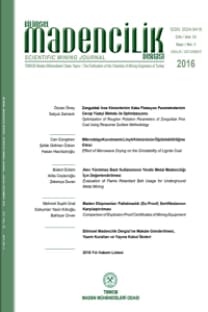DÜŞÜK TENÖRLÜ MANYETİT CEVHERİNİN MANYETİK AYIRMA VE YERÇEKİMİ İLE ZENGİNLEŞTİRİLMESİ: TANE BOYU ETKİSİ
ENRICHMENT OF LOW-GRADE MAGNETITE ORE BY MAGNETIC AND GRAVITY SEPARATIONS: EFFECT OF PARTICLE SIZE
___
- Akbari, H., Noaparast, M., Shafaei, S. Z., Hajati, A., Aghazadeh, S., Akbari, H., 2018. A Beneficiation Study on a Low-Grade Iron Ore by Gravity and Magnetic Separation. Russian Journal of Non-ferrous Metals, 59 (4), 353-363. doi: 10.3103/S1067821218040028 Harris, D. C., 2010. Quantitative Chemical Analysis. 8. Edition, W. H. Freeman and Company, New York, Chapter 1-4 Stoichiometric Calculations for Gravimetric Analysis.
- He, J., Liu, C., Hong, P., Yao, Y., Luo, Z., Zhao, L., 2019. Mineralogical Characterization of the Typical Coarse Ore Particles and the Potential to Discharge Waste Gangue Using a Dry Density-Based Gravity Separation. Powder Technol. 342, 348-355. doi: 10.1016/j.powtec.2018.10.010
- Nayak, N. P., Pal, B. K., 2013. Beneficiation of Banded Hematite Jasper Using Falcon Concentrator: An Alternative to Iron Ore Resources. Research Open Journal of Mineral and Mining Engineering, 1 (6), 8-14.
- Özcan, O., Çelik, I. B., 2016. Beneficiation Routes for Upgrading Iron Ore Tailings with Teethered Bed Separator. Separation Science and Technology, 51 (17), 2844-2855. doi: 10.1080/01496395.2016.1218514
- Seifelnassr, A. A. S., Moslim, E. M., Abouzeid, A. Z. M., 2012. Effective Processing of Low-Grade Iron Ore Through Gravity and Magnetic Separation Techniques. Physicochem. Probl. Miner. Process., 48 (2), 567-578. doi.org/10.5277/ppmp120220
- Sivrikaya, O., Arol, A. I., 2012. Evalution of Low- Grade Iron Ore Deposit in Erzincan-Turkey for Iron Ore Pellet Concentrate Production. Physicochem. Probl. Miner. Process., 48 (2), 475-484. doi: doi.org/10.5277/ ppmp120213
- Vapur, H., Top, S., Altıner, M., Uçkun, Ş., Sarıkaya, M., 2020. Comparison of Iron Ores Upgraded with Falcon Concentrator and Magnetic Separators Assisted by Coal Reduction-Conversion Process. Particulate Science and Technology, 38 (4), 409-418. doi: 10.1080/02726351.2018.1548532
- Worldsteel Association, 2019. World Steel in Figures. URL:https://www.worldsteel.org/en/dam/ jcr:96d7a585-e6b2-4d63-b943-4cd9ab621a91/ World%2520Steel%2520in%2520Figures%25202019. pdf
- Yalçın, T., Ateşok, G., 1979. Enrichment of Iron Ores. Madencilik, 18 (2), 20-32. (In Turkish). Zhang,X.,Gu,X.,Han,Y.,Parra-Alvarez,N.,Claremboux, V., Kawatra, S. K., 2019. Flotation of Iron Ores: A Review. Mineral Processing and Extractive Metallurgy Review. doi: 10.1080/08827508.2019.1689494
- ISSN: 2564-7024
- Yayın Aralığı: Yılda 4 Sayı
- Yayıncı: TMMOB Maden Mühendisleri Odası
Hikmet Sis, Tekin Karaağaç, Mustafa Birinci, Tufan Kıyak
DÜŞÜK KALİTE KUVARS KUMLARININ FLOTASYON VE OKSALİK ASİT LİÇİ İLE ZENGİNLEŞTİRİLMESİ
Ş.beste AYDIN, Ceyda OĞUZ, Alim GÜL
ENRICHMENT OF LOW GRADE MAGNETITE ORE BY MAGNETIC AND GRAVITY SEPARATIONS: EFFECT OF PARTICLE SIZE
Hikmet SİS, Tekin KARAAĞAÇ, Mustafa BİRİNCİ, Tufan KIYAK
BAKIR İÇEREN SİYANÜR LİÇİ ÇÖZELTİLERİNDEN ALTININ SEÇİMLİ OLARAK KAZANIMINDA ADSORBANLARIN ETKİNLİĞİ
Deus Albert MSUMANGE, Ersin Y. YAZICI, Oktay CELEP, Hacı DEVECİ
OLİVİNİN REFRAKTER HAMMADDESİ OLARAK KULLANIMI İÇİN DEMİR İÇERİĞİNİN MANYETİK AYIRMA İLE AZALTILMASI
KUYUMCULUK KÖKENLİ ARTIKLARDAN ALTIN VE GÜMÜŞÜN GERİ KAZANIMI
Tülin ULUCAN, Mustafa ÖZER, Hüseyin BAŞTÜRKCÜ, Fırat BURAT
Ş.beste AYDIN, Ceyda OĞUZ, Alim GÜL
YERALTI MADENLERİNDE MADEN ARITMA SIRASINDA MASOVİK MADENCİLİK UYGULAMASI
